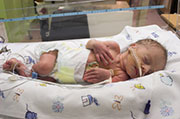Big variation seen in prescribing rates, despite little difference in infection rates
MONDAY, April 20, 2015 (HealthDay News) — Antibiotics appear to be overused in many neonatal intensive care units, new research suggests. The findings were published online April 20 in Pediatrics.
In the study, California health officials analyzed the medical care of 52,061 infants in 127 neonatal intensive care units across the state in 2013. Antibiotic use in these units ranged from 2.4 percent of patient-days to 97 percent of patient-days. These percentages represent the number of days out of 100 that an infant received at least one antibiotic or antifungal medication. Approximately half the neonatal intensive care units used antibiotics less than 25 percent of patient-days, and half used more.
However, antibiotic use in the neonatal intensive care units did not correspond to the rates of infections, surgical cases, infant deaths, or cases of necrotizing enterocolitis. The researchers concluded that many antibiotics are likely being used when they are not needed.
“Given the huge variation in antibiotic use with little evidence of clinical benefit from liberal compared with conservative antibiotic use, this issue is ripe for major quality collaborative approaches. Sources of variation in the use of antibiotics need to be identified and understood, including unit culture and beliefs about infection, variation in thresholds for starting and stopping therapy, and emphasizing the importance of using potentially harmful therapies only when there is clear benefit,” write the authors of an accompanying editorial. “There is great potential to substantially reduce both risk and cost for this vulnerable population through more judicious use of antibiotics.”
Copyright © 2015 HealthDay. All rights reserved.








